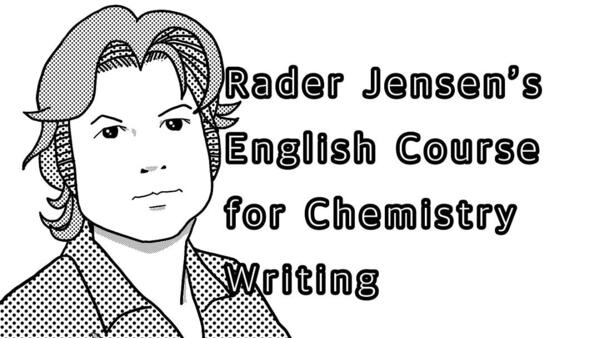CSJ Journals
[化学論文のための英語講座] 第52回:冠詞 Part1
(English version is here.)
冠詞(article)は名詞と名詞句の特別な修飾語で形容詞として考えると良いです。冠詞はゲルマン系やロマンス系言語では一般的であり不可欠ですが、日本語では似ている言葉はありませんので、日本人にとって使うのは難しいかもしれません。
英語では冠詞が必須で、定冠詞「the」と不定冠詞「a, an」の二つがあります。冠詞は名詞または名詞句を限定します。定冠詞「the」は特定のものを示します。代わりに「a, an」は不特定のものを表します。例外や慣用句がありますが、普通はどれが適切なのかを簡単に判断できます。名詞について次の三つの質問に答えると判断できます。
a) 名詞は数えられる「countable」 or 数えられない「uncountable」
b) 名詞は限定「definite」 or 非限定「indefinite」
c) 名詞は単数「singular」 >or 複数「plural」
a)~c)を組み合わせると以下の6パターンになります。
| Countable | definite | singular | the | (1) |
| definite | plural | the | (2) | |
| indefinite | singular | a, an | (3) | |
| indefinite | plural | no article | (4) | |
| Uncountable | definite | - | the | (5) |
| indefinite | - | no article | (6) |
※ Uncountable ではsingularやpluralでの使い分けはありません
不定冠詞「a」は名詞の頭文字が子音の場合に使い、不定冠詞「an」は名詞の頭文字が母音の場合に使います。
日常会話ではこの質問は簡単ですが、化学の環境ではちょっと複雑な使われ方をすることが意外と多いです。以下の例文を見てみましょう。
1. The amine salt was dissolved in 10 mL of water.
訳文:アミン塩は水10mLに溶解された。
解説:ここでは、アミノ塩は特定で数えられない名詞(5)なので「the」を使い、水は不特定で数えられないもの(6)なので冠詞を使いません。
2. The complex releases a water of hydration upon heating.
訳文:錯体は加熱すると水和水を放出する。
解説:この例文では、錯体は特定で数えられる単数の名詞(1)なので「the」を使い、水は不特定で数えられる単数の名詞(3)なので「a」を使います。
例文1では水は数えられないが、例文2では水が数えられるのはなぜかを考えましょう。例文1では水が溶媒として用いられているので数えられませんが、例文2では水は分子規模で用いられているので数えられます。化学ではこのような意味合いによる使い分けがかなり多いです。
a)~c)の質問で一番難しいのは限定か非限定かです。重要なのは聞き手の立場から見てその名詞を知っているかどうかです。最初に現れる時は非限定、それ以後は限定と考えると良いです。
次回は冠詞 Part2です。
Articles are special modifiers of nouns and noun phrases, and can be thought of as adjectives. Although articles are ubiquitous and indispensable in Germanic and Romance languages, there is nothing similar in Japanese and thus, their use can be difficult for Japanese people.
In English there are two articles, definite article the and indefinite article a/an. They are essential. Articles limit nouns and noun phrases. Definite article the is used with specified objects whereas in contrast, a/an is used with unspecified objects. Although there are idioms and exceptions, deciding which is appropriate is usually simple. The correct article can be determined by answering the following three questions.
a) Is the noun countable or uncountable?
b) Is the noun specific (definite) or non-specific (indefinite)?
c) Is the noun singular or plural?
Combining a~c provides the following six patterns.
| Countable | definite | singular | the | (1) |
| definite | plural | the | (2) | |
| indefinite | singular | a, an | (3) | |
| indefinite | plural | no article | (4) | |
| Uncountable | definite | - | the | (5) |
| indefinite | - | no article | (6) |
*Uncountable nouns are not separated as singular or plural.
Indefinite article a is used with nouns beginning with a consonant, and indefinite article an is used with nouns beginning with a vowel. In everyday conversation these questions are simple, however, in chemistry complicated usage is unexpectedly frequent. Let us take a look at the following examples.
1. The amine salt was dissolved in 10 mL of water.
Explanation: Here, amine salt is a specified, uncountable noun (5) and thus the is used. Water is an unspecified uncountable noun (6) and thus no article is used.
2. The complex releases a water of hydration upon heating.
Explanation: In this example, complex is specified and countable (1) and thus the is used. Water is unspecified and countable (3) and thus a is used.
Let us consider why in sentence 1 water is uncountable yet in sentence 2 water is countable. In example 1, water is treated as a solvent and thus is uncountable, however, in example 2 water is viewed on a molecular scale and thus is countable. In chemistry, change in use depending on this sort of context is quite frequent.
In a) through c) the most difficult question is definite or indefinite. Of importance is whether the noun is known or unknown from the viewpoint of the reader or listener. One can think of the noun as being indefinite when it first appears; subsequently, it can be thought of as definite.
At next time, we will discuss about Article 2.
